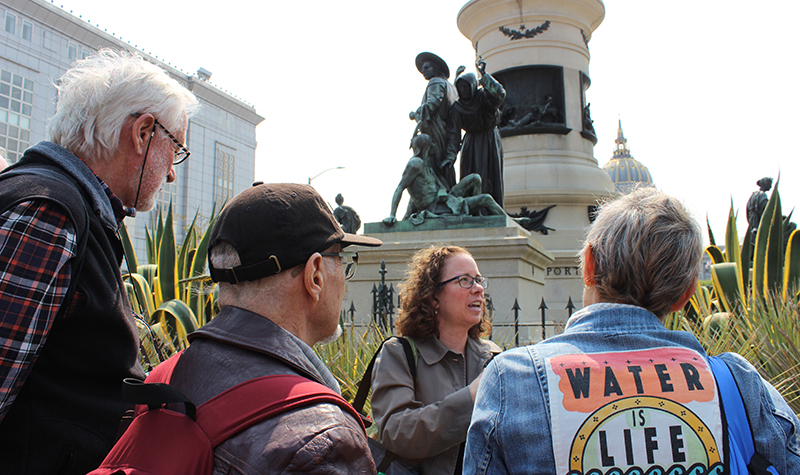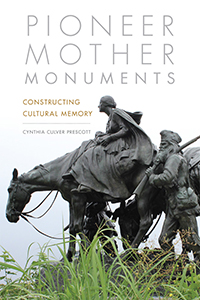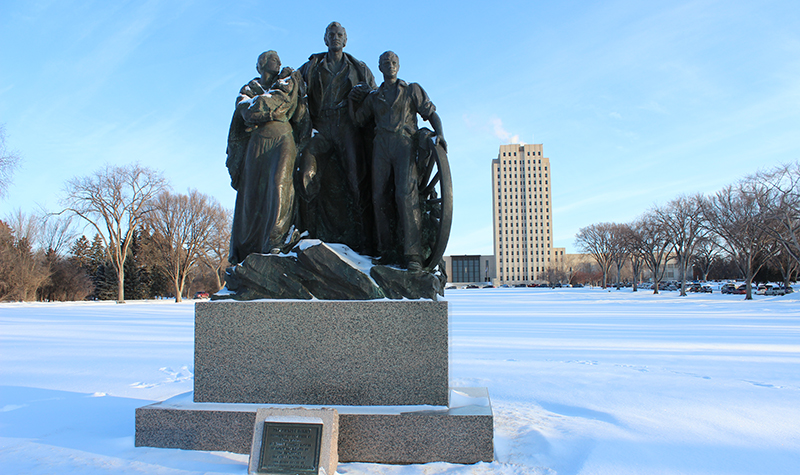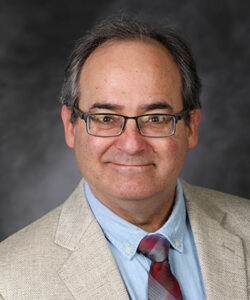Challenging Pioneer memory
There’s more to ‘Pioneer Mother Monuments’ than meets the eye, UND’s Cynthia Prescott documents in award-winning book

A monument represents a set of values, frozen in time. But times change, and values change, too.
What happens when the values of a later era conflict with those ensconced in a monument?
In her research, Cynthia Prescott, associate professor of history at UND, asks that question about a type of statuary common throughout the American West: “Pioneer Mother” monuments. The time has come for the United States to take a fresh look at these monuments, many of which have stood in town squares and on statehouse grounds for more than a century, Prescott suggests.

Will the monuments eventually come down, as is happening with many Confederate and other monuments around the country? That’s not clear. But whatever the outcome, as years pass and the issue is debated in Colorado, California, North Dakota and elsewhere, Prescott’s research likely will play a key role.
In May, that research was recognized by the Western Association of Women Historians, which awarded the 2020 Gita Chaudhuri Prize to Prescott’s book, “Pioneer Mother Monuments: Constructing Cultural Memory.”
The Gita Chaudhuri Prize is awarded to the “best monograph about the history of women in rural environments,” the Association notes. In making the award, the Association says it looks for “originality of conception and analysis, wide research and careful documentation, and clarity of expression.”
An ‘original and innovative tapestry’
Prescott’s book has all that and more, said Hans Peter Broedel, chair of the Department of History and American Indian Studies at UND.

“All of us in the department are extremely pleased and proud to hear that Dr. Prescott has received the prestigious Gita Chaudhuri Prize for her groundbreaking book, ‘Pioneer Mother Monuments,’” Broedel told UND Today.
“That this is a prize for rural history is particularly apt for us here in North Dakota, as is her focus on our collective remembrance of the pioneer experience.
“And certainly the prize is well deserved,” Broedel continued. “Cindy’s book weaves together the products of quite different historical methodologies into an altogether original and innovative tapestry.
“Congratulations, Cindy!” he said.
Prescott thanked Broedel and said she was humbled by the award.
“I’m honored to be recognized by the Association,” she said.
Moreover, “this particular prize is for books on women in a rural setting anywhere in the world,” Prescott said.
“I appreciate that the award suggests that my project may contribute to a better understanding of rural people around the globe, which is something I care deeply about.”
‘Progress,’ then and now
Pioneer Mother monuments typically depict saintly mothers, sturdy men and wholesome pioneer families, observers note. But while those traits meant “progress” to artists and audiences in generations past, many Americans in 2020 look at those same sculptures and see monuments to white cultural supremacy.
In her 2019 book, Prescott shows how both sets of observations came about.
In fact, the earliest pioneer monuments memorialized white cultural supremacy quite explicity, Prescott noted.
“For example, there’s one from San Francisco, Calif., in the 1890s,” she said. Among other displays, it shows a conquering vaquero — a Mexican cowboy — and a missionary, the latter of whom is towering over and looking down on a fallen American Indian man.
“Showing Native people ‘progressing up’ to white civilization was intended to be very explicit in that work,” Prescott said.
Likewise, the original, 1904 design for the Pioneer Monument near Civic Center Park in Denver featured a central pillar topped by a Native person on horseback. But Denver residents expected the pinnacle to represent “American Progress” — and so, under pressure from the Colorado Society of Pioneers and others, the sculptor replaced the Indian figure with a sculpture of Kit Carson.
As the Rocky Mountain News editorialized at the time, “(W)e don’t want the Indian dominating a structure erected to the men whose business was getting rid of Indians.”
Then over the early decades of the 1900s, Prescott said, “the Pioneer monuments shift from explicitly depicting whites subjugating Native peoples to just erasing Natives from the scene altogether.”
In that evolution, “initially you start seeing these Pioneer men, usually dressed in buckskin, marching off into the wilderness,” she continued.
“Then it transitions to a Pioneer mother in a sunbonnet. And that’s the image that really became iconic, and shows up in sculptures across the country.”
In a companion website to her book, Prescott identifies and maps some 200 sculptural monuments to the pioneers who settled on Western lands. Many of these show Western women, either alone or with their families — and the sculptures’ purpose is clear:
“Pioneer mothers in sunbonnets stood for white ‘civilization’ winning in the West,” Prescott writes on her website. Moreover, the sculptures “offered a conservative model of womanhood to contrast flappers wearing short dresses and bobbed hair and women’s growing sexual freedom.
“More recent monuments, such as Goodland, Kans.’s ‘They Came to Stay’ and Omaha, Neb.’s ‘Pioneer Courage,’ do not directly engage racial politics. As their titles suggest, these statues honor pioneer families’ grit, and they teach local history.
“But these statues still represent a racist view, ignoring the cost of white settlement on Native lands. Like earlier monuments, they reinforce white dominance and erase ethnic diversity in the American West.”

Monuments matter
When Saddam Hussein’s statue in Baghdad was toppled in 2003, the world recognized that one era in Iraqi history had ended and a new one had begun.
In the United States, meanwhile, monuments have been the source of significant controversy in recent years – and even recent weeks. Confederate, Christopher Columbus and some other monuments are being removed, and monuments commemorating Civil Rights events and heroes are being built or suggested, in communities nationwide.
Does that mean the days of the Pioneer monuments are numbered?
The San Francisco statue described above already has been removed. So has a statue in Kalamazoo, Mich., that likewise depicted a white towering above a Native person. At the University of Oregon on June 13, a Pioneer statue and a Pioneer Mother statue were torn from their pedestals and vandalized.
As for other such statues around the country, “there is no one-size-fits-all solution,” Prescott said.
But at the very least, “it is time for us to begin these difficult conversations, so that future generations will learn what happened in the past, and how our memories of the past have changed over time. That is how we will build a more inclusive future.”



